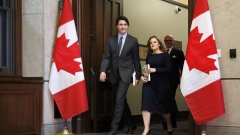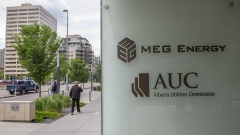Aug 1, 2023
US-EU Steel Talks Inch Ahead as Time for a Deal Runs Short
, Bloomberg News

(Bloomberg) -- The US and European Union are unlikely to finalize a legally binding agreement to govern trade in steel and aluminum this year, setting up a decision to either extend an October deadline or allow the return of tariffs on billions of dollars of transatlantic exports.
Talks on the so-called Global Arrangement on Sustainable Steel and Aluminum have intensified in recent weeks and progress has been made in the key area of how to measure and tackle oversupply from nations including China, according to people familiar with the discussions. But absent a final deal by Oct. 31, Trump-era tariffs — and EU retaliatory measures — would automatically return on more than $10 billion of exports if the two sides don’t extend the current truce.
The GSA aims to settle a conflict that started in 2018, when Trump slapped tariffs on steel and aluminum exports from Europe, citing risks to national security. Two years ago, the US and the EU agreed to pause the punitive measures in an effort to find a permanent solution.
US and EU officials are now looking to translate the progress made on non-market excess capacity, which is one of the core elements of the GSA, into a text, one of the people said. The aim would be to have a path forward in time for a US-EU summit between President Joe Biden and European Commission President Ursula von der Leyen planned for the fall.
Even though both sides insist that Oct. 31 is a hard deadline, tangible progress on curbing overcapacity may be significant enough to convince the US and EU to extend talks past that date without triggering the tariffs, said some of the people, who asked not to be identified because the talks are private.
Since the two sides remain far apart on other aspects of the GSA as well as internal procedures, it’s improbable they’ll be able to conclude and ratify a comprehensive agreement this year, which makes an extension of the temporary truce more plausible, the people said.
A spokesperson for the Office of the US Trade Representative said Washington remains focused on making tangible progress on addressing carbon intensity in the steel and aluminum sectors and tackling overcapacity by the end of October deadline. A spokesperson for the European Commission said the EU and US are committed to achieving an ambitious outcome on the GSA and are fully engaged on the process, holding continuous exchanges on the possible contours of the arrangement. Officials on both sides said the talks had yet to produce a decisive breakthrough.
Wang Jiangping, vice minister of China’s Ministry of Industry and Information Technology, said his country’s steel industry has pushed for structural reform with supplies, and made significant progress with resolving oversupplies during a meeting with the CEO of Brazilian mining firm Vale SA on Tuesday, according to a statement from the agency.
The GSA is seen as a lasting solution to settle the dispute. As part of the steel and aluminum accords, the US had proposed joint tariffs to hit steel produced with high carbon emissions and global steel overcapacity, while allowing for preferential access for participants of the arrangement that meet its standards.
In December, US Trade Representative Katherine Tai proposed the creation of a club of nations that would agree to raise tariffs on imports of foreign steel and aluminum produced by carbon-intensive practices — a move aimed squarely at China.
Adding to the urgency to reach a deal or at least avoid a return of tariffs, the political clock is ticking: EU parliamentary elections are slated for June next year and Biden faces a re-election fight in November 2024.
Talks stalled for months, with frustrations mounting on both sides, the people said. The US often complained that the EU wasn’t being constructive and creative enough in its approach, and the EU argued that some of the US proposals were unworkable and not compatible with international trade rules.
The Biden administration was also seeking an exemption from the EU’s carbon border levy as part of the metals accord and has been looking to introduce safeguards and snapback provisions that could see tariffs return if certain conditions in European exports are triggered.
The EU has been pushing for the Biden administration to drop tariffs altogether, or to rework the terms of the current truce, which it views as unfavorable, one of the people said.
The 2021 deal sets a US import tariff rate quota limit on 3.3 million metric tons of EU steel and 384,000 tons of EU aluminum. Last year aggregate annual EU exports of covered steel products to the US were 3.97 million tons and covered aluminum products were 285,000 tons. That means 670,000 tons of EU steel exports were subject to a 25% tariff and zero EU aluminum exports were subject to the 10% tariff.
Any extension would very likely continue on the same conditions, some of the people said.
Carbon Pricing
On the second main plank of the GSA — taxing carbon-intensive imports — the two sides remain distant. One challenge is that the US doesn’t yet have a methodology to price carbon emissions, nor does it have a system it applies domestically on its own firms, one of the people said. The EU worries that any joint action could be deemed arbitrary and go against international trade rules, which is a red line for Brussels.
The EU has such tools in place, through an internal trading system and its carbon border adjustment mechanism, which levies an equivalent price on carbon intensive goods produced outside the bloc.
Brussels’ stance is that the GSA participants should be able to implement their own carbon-pricing systems and measures, the person said. The Biden administration could decide to introduce tariffs unilaterally but it would be responsible for defending those.
That could be another contentious point in discussions. Another person said the two sides should be working together to develop ideas on how to defend the GSA if it comes under scrutiny by the World Trade Organization. On carbon pricing, the US is confident that the proposals it has offered to the EU can withstand WTO scrutiny, according to a person familiar with the talks.
The US is currently running an investigation into the intensity of emissions in its steel and aluminum industries while the EU is working to determine which third-country systems could be deemed equivalent to its own. The two processes could potentially lead to greater harmonization between the two partners’ measures as part of the GSA but neither exercise will be completed by the fall.
--With assistance from Bryce Baschuk, Joe Deaux, Jorge Valero and Debby Wu.
(Updates with comment from the Chinese Ministry of Industry and Information Technology in the eighth paragraph.)
©2023 Bloomberg L.P.








